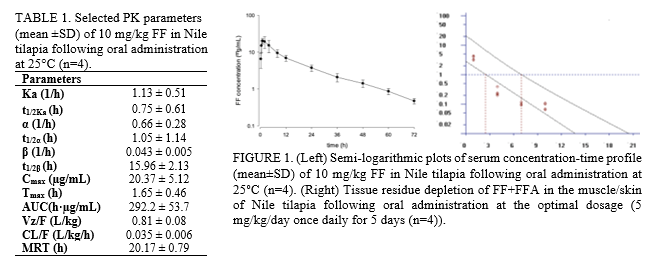DETERMINATION OF OPTIMAL ORAL DOSAGE AND WITHDRAWAL TIME OF FLORFENICOL IN NILE TILAPIA Oreochromis niloticus REARED AT 25°C
Antimicrobials misuse in aquaculture can bring more harms than benefits. Since pharmacokinetic information critical for determination of dosage and withdrawal time (WDT) is temperature dependent for aquatic species, prudent use of antimicrobials should include customized optimal dosing regimen taken into consideration the rearing temperature and antimicrobial sensitivity. The current study used a pharmacokinetic-pharmacodynamic (PK-PD) approach to calculate the optimal dosing regimens of florfenicol (FF) in multiple MIC levels when Nile tilapia was reared at 25°C. Then, the optimal dosage targeting MIC of 3 µg/mL was given orally for 5 consecutive days to evaluate tissue depletion and WDT and compared to those of the conventional recommended dosage. The optimal doses determined by PK study (Table 1 and Figure 1) of a single oral 10 mg/kg FF at 25°C were 1.45±0.41, 2.89±0.83, 4.34±1.24 and 5.79±1.65 mg/kg/day for MICs of 1, 2, 3 and 4 µg/mL, respectively. Consequently, a round-up dosage of 5 mg/kg/day and a general dosage of 10 mg/kg/day were comparably studied for their tissue depletion and WDTs. The serum concentrations at 24 h after the last optimal dose were 3.26 μg/mL, which was comparable to the target MIC of 3 μg/mL; whereas, the corresponding serum concentration of the 10 mg/kg/day was 8.06 μg/mL. By using the sum of FF and its major metabolite florfenicol amine (FFA) as the marker residue and a MRL of 1 µg/g, the WDT determined by linear regression analysis following the optimal dosage was 7 days, whereas that of 10 mg/kg/day was 10 days (Figure 1). The current study suggested that overdosing may occur at lower rearing temperature and the general dosage was likely determined at temperatures higher than 25°C. With the established optimal dosing regimen, serum concentrations could be maintained above the target MIC and the WDT be shortened. Further investigations of optimal dosages and WDT at higher rearing temperature are warranted to elucidate the degree of influences temperature has, and might explain the observation of sporadic over- and futile dosing of FF in the field.
